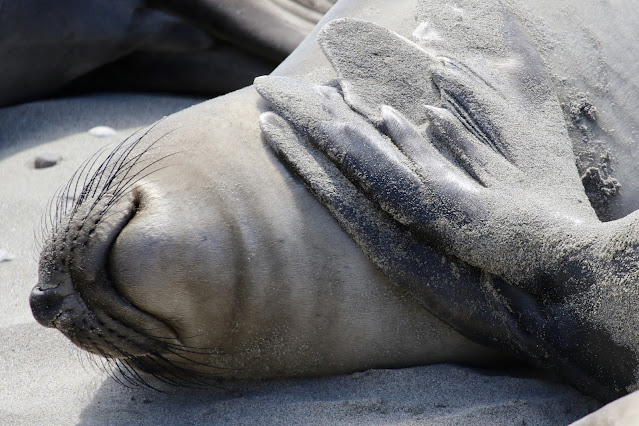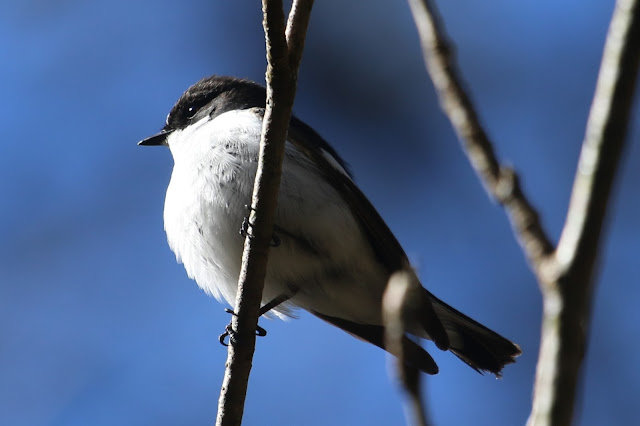Friday 7 April 2023
 |
| American Avocet - Henderson NV |
When we decided on a Las Vegas stopover, I'd assumed that there would be little (or no) wildlife interest in the desert city. I was wrong. Some online research pointed me to a birding oasis in the nearby city of Henderson, less than half and hour's drive from the Strip.
I arrived at the entrance of the Henderson Bird Viewing Preserve (below) just after opening time at 7am. A few cars were parked there; the local birders had beaten me to it.
 |
| Henderson Bird View Preserve NV - entrance |
Like many great birding locations, the
Henderson Bird Viewing Preserve occupies a complex of sewage treatment ponds. It was set up as a partnership between the city and volunteers, including the local Audubon Society. To say that the surrounding land has little wildlife value would be an overstatement; it has NO wildlife value, being a mix of sand, gravel and development projects. But all that changes when you move inside the reserve fence. It is no exaggeration to say that there were birds all over the place: on the ponds, over the ponds, in the bushes and on feeders near the Visitor Centre. More details about the reserve, including a site map, can be found
here (opens in new window).
 |
| One of the ponds at Henderson NV |
 |
| Viewing screen at Henderson NV |
The action started as soon as I stepped out of the visitor centre, with a bird feeder that was festooned with birds, both on the feeder itself and on the ground below. But my eyes were first drawn to … a rabbit – a Desert Cottontail (below), which is the main cottontail species in the western USA.
 |
| Desert Cottontail - Henderson NV |
The cottontail was sharing the fallen seed with Mourning Doves and female Red-winged Blackbirds (one can be seen behind the bunny). These are strikingly different to their male counterparts, which weren't around. Very strange. I was mulling this over when a large hawk materialised out of nowhere and zoomed past the feeder, scattering the blackbirds. There were two possible candidates, Sharp-shinned and Cooper’s Hawks, that look very similar. From its larger size, I’m happy that this bird was a Cooper’s Hawk.
A small bird flew into a bush next to the feeder: it was a Verdin (below), one of my target species for this leg of the holiday.
 |
| Verdin - Henderson NV |
This is a male Verdin: note the rufous shoulder patch (lesser coverts) as well as the yellow head. Verdins are a bit of an anomaly: they are the sole representative of the Penduline Tit family (Remizidae) in the Americas. A desert-dwelling species, their range extends from east California to west Texas, and down into Mexico.
In a nearby bush was a Audubon’s Warbler (below). This is a first winter bird – brownish with a pale throat. Audubon's Warbler was previously a subspecies of the familiar Yellow-rumped Warbler, but it has now been elevated to the rank of full species - as has its counterpart the Myrtle Warbler. (This has given me an 'armchair tick': never the most satisfying birding experience, but nobody turns them down!).
%20Henderson%20NV%207.4.23.jpg) |
| Audubon's Warbler (1st w) - Henderson NV |
For completeness, here (below) is an Audubon's Warbler in full adult plumage, also from Henderson. There were a lot of them around. The reserve at Henderson is obviously a magnet for migrant birds.
%20Henderson%20NV%207.4.23.jpg) |
| Audubon's Warbler (adult) - Henderson NV |
The visitor centre hummingbird feeders were busy. Seeing any hummingbird is a thrill for this UK-based birdwatcher. While several species are possible at Henderson, all of the ones this morning were Anna’s Hummingbirds (below), the same as we had seen on the coast. Hummingbirds can be awkward to identify - partly due to their speed of movement, but also because their iridescent plumage can show different colours with different lighting. This is shown by the two photos below, which I think are of the same bird. The red throat (gorget) and crown, coupled with the grey breast, identify it as Anna’s Hummingbird.
 |
| Anna's Hummingbird - Henderson NV |
 |
| Anna's Hummingbird - Henderson NV |
Turning my attention to the water, I scanned through the scatter of ducks bobbing around on the nearest pond (pond 1). These were: Ruddy Ducks, Shovelers, Buffleheads and my first Redhead (below).
 |
| Redhead - Henderson NV |
Distinguished from Canvasback by the blue (and non-tapered) bill with a black tip, Redheads look very like ‘our’ (Common) Pochard but with a brighter colour to the head and a more distinct forehead.
Comparing images of the three species, Common Pochard almost looks like an intermediate between Canvasback and Redhead. Also here was a Common Gallinule, which has been split from ‘our’ Common Moorhen, but looks very much the same. Zipping over the water were hirundines that, at first sight, looked like Sand Martins. In fact, they were Northern Rough-winged Swallows, which have a brown (not white) throat.
I walked on to pond 8, which was where most of the waders (shorebirds) were hanging out.
 |
| Black-necked (Black-winged) Stilt - Henderson NV |
The morning light wasn't ideal for photography, but I had a go - see the American Avocet at the start of this post and the Black-necked Stilt (above). In assembling my world bird list I use the HBW/Birdlife International Checklist, which does me no favours with the stilts: Black-necked (Americas) and White-headed (Australia) are both lumped with Black-winged Stilt, even though they can be easily separated visually. All of them share the over-long reddish legs and dagger-like bill, though.
 |
| Lesser Yellowlegs - Henderson NV |
A single Lesser Yellowlegs (above) - note the smaller size and mainly unbarred belly - was stalking around the avocets and stilts on pond 8, while on pond 4 next door, these Long-billed Dowitchers (below) were busily feeding; Henderson sits on the edge of their breeding and wintering areas, so these guys were probably on passage north.
 |
| Long-billed Dowitchers - Henderson NV |
The waders were all well and good, but what I really wanted to see were some desert specialists, and the gravel path between ponds 4 and 8 obliged with a pair of Gambel’s Quails. The first pair that I came across were quite mobile, legging it quickly away from me (and who can blame them?). Not a great photo, as a result.
 |
| A pair of Gambel's Quails - Henderson. |
But at the eastern corner of pond 8, a male gave me a closer view (below).
 |
| Gambel's Quail (male) - Henderson NV |
While Gambel’s Quails look very much like their Californian Quail cousins, the ranges of the two species hardly overlap, so confusion is unlikely. Gambel’s Quail is a common desert resident with limited distribution in the south-western states and part of northern Mexico. Las Vegas is right on the edge of the species’ range. So, a good bird to see – neat, and almost comical with its drooping head plume. I was very pleased. Like many quails and partridges, Gambel’s Quails are often found in groups (coveys): apparently, these can contain up to 16 birds, although the ones at Henderson were mainly in pairs. The breeding season was upon us.
A series of exotic sounding whistles were coming from a patch of reeds at the corner of pond 8. The source was this displaying Great-tailed Grackle (below). He had an audience of at least two admiring (possibly) females, who are just about visible down in the reeds on the right.
 |
| Great-tailed Grackles - male (displaying) and female (bottom right) - Henderson NV |
Within the USA, Great-tailed Grackles have shown a wide and speedy range expansion across the central and south-western states since the late 1800s, starting from southern Texas and following the development of urban areas. There were a couple on the roof of our Las Vegas hotel next morning.
 |
| Looking west towards central Las Vegas from Henderson Bird Viewing Preserve NV |
The panorama above, looking over pond 8, shows the tower blocks of the Strip with the mountains behind, admittedly foreshortened by the 400 lens. Just to the right of the hotels you can just make out a range of low brick-red hills. This is Red Rock Canyon, which will be the subject of my next blog post.
Pond 9 contained a good range of waterfowl, including these Ring-necked Ducks (below).
 |
Ring-necked Ducks - Henderson NV
|
I’ve seen some vagrant Ring-necked Ducks in the UK (for example at RSPB Radipole Lake in Dorset), but these were my first in their native range. And very smart they are too. The species is strictly North American, and Henderson is well out of the usual breeding area, so these birds were either wintering here or on passage. Also on the pond were a pair of Cinnamon Teals and plenty of Shovelers. It was odd to see such a mix of familiar and (to me) exotic species on the same pond.
 |
| Ruddy Duck (male) - Henderson NV |
Back on pond 1 a Ruddy Duck drake (above) had drifted into view – much closer than the ones at Moss Landing. Also North American, this species ranges down as far as northern Nicaragua and the big Caribbean islands (its scientific species name is jamaicanesis). Once a familiar sight on UK wetlands, it has now been (almost) completely eradicated from our side of the Atlantic. But that's a separate story.
It was time to return to the family, who had enjoyed a leisurely breakfast at our hotel on the Strip. But we were soon on the road again, heading for Red Rock Canyon.
To be continued ...






%20Henderson%20NV%207.4.23.jpg)
%20Henderson%20NV%207.4.23.jpg)















%20Deer%20Ani%20Nuevo%20SP%20CA%203.4.23.JPG)


























%20Yarner%20Wood%2020.4.24%20edit2.jpg)







%20Emsworthy%20Mire%2020.4.24.JPG)



